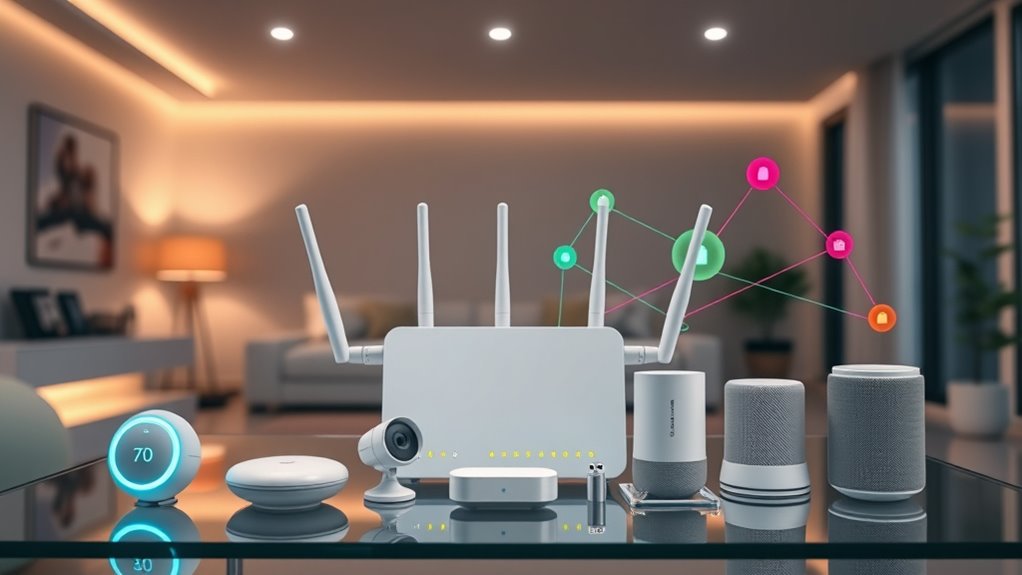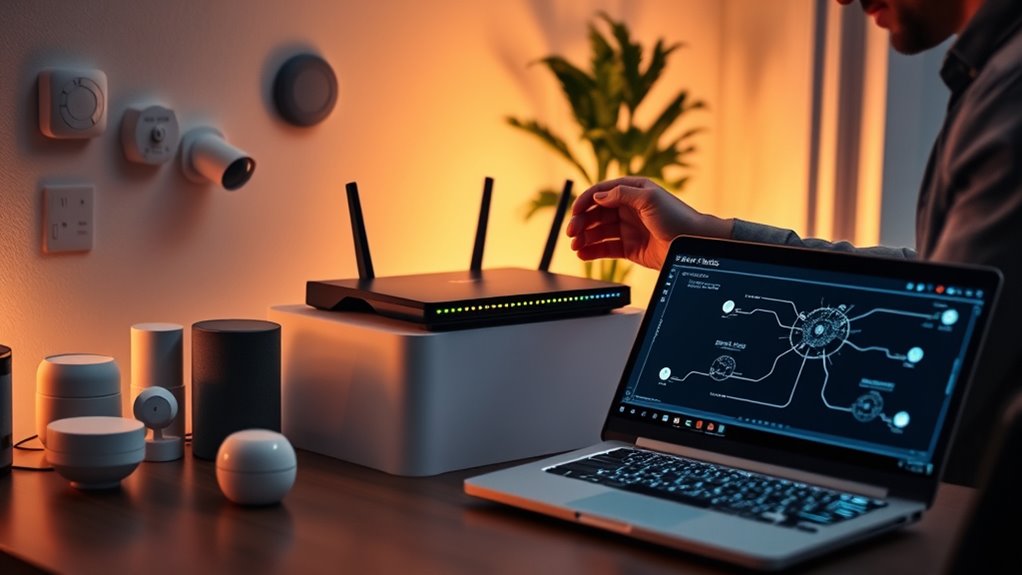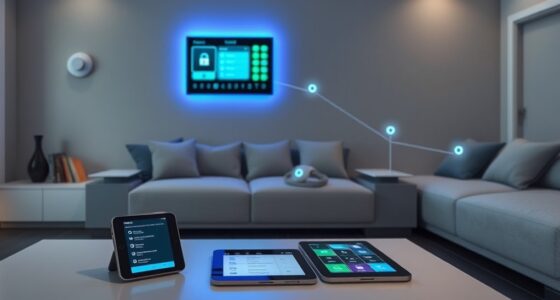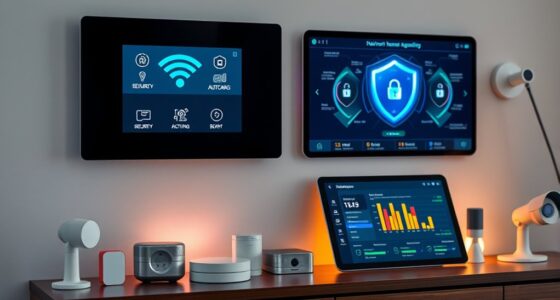To implement zero-trust networking for your home IoT, start by understanding its core principles like strict verification and continuous monitoring. Create an inventory of all your devices, identifying their vulnerabilities, and then isolate them on a separate network or VLAN to prevent breaches. Set strong, unique passwords, enable multi-factor authentication, and regularly update firmware. Keep monitoring your network for unusual activity. Continue exploring each step to build a robust, secure smart home environment.
Key Takeaways
- Inventory all IoT devices, identify vulnerabilities, and document their firmware versions for targeted security measures.
- Segment IoT devices into a separate network or VLAN to isolate potential breaches.
- Implement strong, unique authentication methods and enforce least privilege access controls for each device.
- Regularly update device firmware, monitor network activity, and utilize anomaly detection tools for ongoing security.
- Continuously review and adjust Zero-Trust policies to adapt to emerging threats and maintain security posture.
Understanding Zero-Trust Principles and Why They Matter for IoT

Understanding Zero-Trust principles is essential because traditional security models no longer suffice in protecting IoT devices within a home network. Instead of trusting devices by default, Zero-Trust emphasizes strict verification and continuous monitoring. You should implement device segmentation, isolating IoT gadgets into separate network segments to limit potential breaches. This prevents compromised devices from accessing critical data or other devices. Trust models in Zero-Trust shift away from assuming devices are safe just because they’re connected; instead, every device and user must prove their identity each time. By applying these principles, you reduce the risk of cyberattacks, data theft, or unauthorized access, creating a more secure environment for your smart home. Zero-Trust isn’t just a concept—it’s a practical approach to modern IoT security. Incorporating ongoing cultural intelligence assessments can help adapt security strategies to evolving threats and diverse user behaviors.
Assessing and Inventorying Your Home IoT Devices

Before implementing Zero-Trust principles, you need a clear picture of all the devices connected to your home network. Start by creating an inventory of your IoT devices through device fingerprinting, which helps identify each device’s unique characteristics and behavior. This process reveals unfamiliar or unauthorized devices. Next, perform firmware analysis on your known devices to check for vulnerabilities, outdated software, or tampering. Keeping track of device types, manufacturers, and firmware versions allows you to assess potential security risks. Document everything systematically, so you understand your network’s landscape. This extensive inventory is essential for applying Zero-Trust principles effectively, ensuring you know exactly what connects to your network and can monitor for anomalies or suspicious activity. Additionally, understanding the industrial juice manufacturing process can help you recognize common device components and their security implications in home IoT setups.
Segregating Iot Devices From Your Main Network

To enhance your home network’s security, you should isolate your IoT devices from your main network. Device segmentation creates a separate network segment for your IoT gadgets, preventing potential breaches from spreading. Network isolation ensures that if an IoT device is compromised, attackers can’t access your primary devices, like your computers or smartphones. Set up a dedicated Wi-Fi network or VLAN specifically for IoT devices, keeping them apart from your main network. This separation reduces vulnerabilities and adds an extra layer of protection. Regularly monitor and update your device segmentation to maintain security. Implementing high-quality projectors with proper contrast ratio and color accuracy can also help ensure your home environment remains secure and efficient. By proactively isolating your IoT devices, you minimize risks and safeguard your personal data and overall home network integrity.
Implementing Strong Authentication and Access Controls

Implementing strong authentication and access controls is essential to prevent unauthorized users from gaining entry to your IoT devices and network. Start by establishing strict password policies, requiring complex, unique passwords for each device and account. Enable multi-factor authentication where available for added security. Confirm device encryption is active, protecting data both at rest and in transit. Limit device access to only trusted users and devices, applying the principle of least privilege. Regularly review and update access permissions to minimize risks. Use secure protocols like WPA3 for Wi-Fi connections. Additionally, staying informed about emerging AI vulnerabilities helps you adapt your security measures proactively. By enforcing these measures, you substantially reduce the chance of breaches, keeping your home IoT environment protected against unauthorized access and ensuring your devices remain safe and private.
Monitoring, Maintaining, and Updating Your Zero-Trust Setup

How can you guarantee your zero-trust setup remains effective over time? Regular monitoring is key. You should frequently check device firmware updates to patch security vulnerabilities and improve performance. Keep your network devices and IoT gadgets current, ensuring they run the latest firmware versions. Implement anomaly detection tools that alert you to unusual activity, which could indicate potential threats or breaches. Maintaining your setup also involves reviewing access controls and permissions periodically to prevent unauthorized access. Schedule routine audits of your network logs and device statuses to identify suspicious behavior early. Staying proactive with updates, monitoring, and anomaly detection helps you sustain a strong zero-trust environment, keeping your home IoT secure and resilient against evolving cyber threats. Additionally, staying informed about new anomalies and emerging vulnerabilities can further strengthen your security posture.
Frequently Asked Questions
How Does Zero-Trust Differ From Traditional Network Security?
You’d notice that zero-trust differs from traditional security by prioritizing strict access controls and network segmentation. Instead of trusting devices inside the network, you verify each access request, assuming potential threats everywhere. This approach minimizes risk by continuously validating users and devices, unlike traditional models that often trust internal devices. By implementing zero-trust, you create a more resilient environment where every connection is scrutinized and segmented, enhancing overall security.
What Are the Common Challenges in Implementing Zero-Trust at Home?
Implementing zero-trust at home often faces challenges like device complexity, which can make managing security policies tough. You may also struggle with user education, as understanding how to properly secure IoT devices isn’t always straightforward. These factors can hinder your ability to establish effective zero-trust practices, requiring patience and continuous learning. Overcoming these hurdles helps guarantee your home network stays protected against evolving threats.
Can Zero-Trust Networking Improve Device Lifespan and Performance?
Zero-trust networking can improve device durability by reducing security breaches that cause hardware stress. It also enhances network efficiency through better traffic management, preventing overloads that slow down devices. By isolating compromised devices and limiting unnecessary data flow, you help extend device lifespan and maintain ideal performance. Implementing zero-trust creates a more secure, stable environment, ensuring your IoT devices operate smoothly and last longer.
Are There Affordable Tools to Help Manage Zero-Trust for Home Iot?
You can find affordable tools to manage zero-trust for your home IoT by exploring budget solutions and DIY approaches. Many open-source platforms and free security tools help implement zero-trust principles without breaking the bank. Additionally, you can customize your own security measures with simple hardware or software setups. These options give you control and protection, making zero-trust practical and accessible for your smart home environment without costly investments.
How Does Zero-Trust Impact User Convenience and Daily Device Use?
Ironically, embracing zero-trust might seem like a hassle, but it actually enhances your user experience by keeping your devices safer. While it may add a few extra steps, it streamlines daily convenience by preventing disruptions caused by security breaches. You’ll find that, over time, this approach creates a smoother, more reliable smart home, where security and ease of use go hand in hand—making your daily routine less stressful, not more complicated.
Conclusion
By adopting zero-trust principles for your home IoT, you fundamentally create a fortress where each device is verified and monitored. Think of it like a security system that only grants access after thorough checks, reducing risks. Visualize your network as a gated community—you control who enters and what they can do. Embracing these steps keeps your smart home safer, ensuring only trusted devices communicate, and giving you peace of mind in a connected world.








